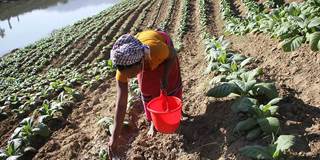Achieving the global Sustainable Development Goals (SDGs) will cost a lot more than $132 billion per year – the total amount of official development assistance currently on offer. To bridge the financing gap, the private sector – with the help of updated financial markets – will have to step up.
WASHINGTON, DC – Achieving the ambitious global Sustainable Development Goals (SDGs) – which include ending poverty, improving global health, ensuring universal education, and mitigating climate change by 2030 – will cost a lot of money. The total will be far more than governments can make available, and the gap cannot be closed by official development assistance, now at $132 billion per year. The private sector, as well as updated financial markets, will be essential.
Until recently, international organizations and governments had relatively well-defined roles in the global development and sustainability agenda, whereas the private sector’s participation in the process was often viewed through the lens of its contributions to economic growth, job creation, and tax revenue. That must now change, with the private sector taking on a broader, more integrated role in the development agenda.
The private sector can become a financier, shifting trillions of dollars of capital toward developing economies. And it can play an important role as an implementer, translating profits into sustained economic growth, social inclusion, and environmental protection. The principles underpinning such measures are anchored in SDG target 12.6, which encourages “companies, especially large and transnational companies, to adopt sustainable practices and to integrate sustainability information into their reporting cycle.”

WASHINGTON, DC – Achieving the ambitious global Sustainable Development Goals (SDGs) – which include ending poverty, improving global health, ensuring universal education, and mitigating climate change by 2030 – will cost a lot of money. The total will be far more than governments can make available, and the gap cannot be closed by official development assistance, now at $132 billion per year. The private sector, as well as updated financial markets, will be essential.
Until recently, international organizations and governments had relatively well-defined roles in the global development and sustainability agenda, whereas the private sector’s participation in the process was often viewed through the lens of its contributions to economic growth, job creation, and tax revenue. That must now change, with the private sector taking on a broader, more integrated role in the development agenda.
The private sector can become a financier, shifting trillions of dollars of capital toward developing economies. And it can play an important role as an implementer, translating profits into sustained economic growth, social inclusion, and environmental protection. The principles underpinning such measures are anchored in SDG target 12.6, which encourages “companies, especially large and transnational companies, to adopt sustainable practices and to integrate sustainability information into their reporting cycle.”